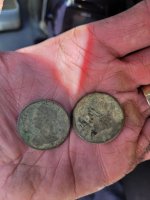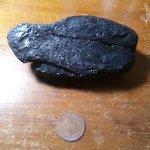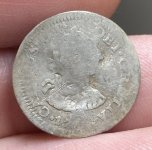KGC4Dixie
Jr. Member
- Sep 13, 2009
- 94
- 3
I wonder what the finding of an ancient coin might prove?
"The remains of a remarkable fort are to be seen on the lands of Mr. Crockett, near Jeffersonville, having evident traces of trenches, and something like a drawbridge. This fort has been evacuated, judging from the timber on it, over two hundred years."
They were circular, varying in size from three hundred to six hundred feet in diameter. An embankment of earth was thrown up five or six feet, and, perhaps, this mounted by palisades. A few of these towns or forts, were built of stone, and sometimes trenches surrounded them. A stone fort, of great size, stood in Abb's valley, in Tazewell county, Virginia, and has but lately been removed.
(Longer excerpt)
History of the settlement and Indian wars of Tazewell County, Virginia: with ...
By George W. L. Bickley
http://books.google.com/books?id=7EHlAq...CAoQ6AEwAA#v=onepage&q=&f=false
...
This mound building leads to some important conclusions, and reminds us strongly of the Egyptian custom of building pyramids.* It is highly probable that the sizes of these mounds are an index to the power of the princes who had them built.
The town built by the Xualan, differed a little from that of the more southern Indians, for they seem to have built a town which was at once a town and a fort. The species of fort needed by the natives of Xuala, differed from what would now be needed by a people who had to defend themselves against the arms and engines of the nineteenth century. The traces of many of these forts are now to be seen in southwestern Virginia. These cannot be Cherokee forts, though they captured the Xualans, and hence became masters of the country, for they do not build forts in the same manner; beside, the trees growing on some of them, prove, beyond doubt, that they have been evacuated three hundred years. That they were towns as well as forts, is proved by the existence of many fragments of earthenware, etc., found on or around them, and from their shape and general location, they were certainly forts.
* Might not the natives have been originally from Egypt, having been driven thence after embracing the religion of the Hebrews ?
They were circular, varying in size from three hundred to six hundred feet in diameter. An embankment of earth was thrown up five or six feet, and, perhaps, this mounted by palisades. A few of these towns or forts, were built of stone, and sometimes trenches surrounded them. A stone fort, of great size, stood in Abb's valley, in Tazewell county, Virginia, and has but lately been removed. A large sassafras, which stood near the center of the walls, might, if proper observation had been made, have given some important chronological information, but which, alas! as is too often the case, has been swept off, as if desirous to obliterate the last vestige of the race of red-men.
The remains of a remarkable fort are to be seen on the lands of Mr. Crockett, near Jeffersonville, having evident traces of trenches, and something like a drawbridge. This fort has been evacuated, judging from the timber on it, over two hundred years.
The roads left by the Indians is another source of information, of which few writers have availed themselves. I beg to refer the reader to a report of a company sent out by the French colony in Louisiana, to search for roads. It is to be found in what is usually called Bienville's report, previously referred to.
The principal Indian trails in Tazewell, led through the Clinch valley, but after the whites began to settle, and the Indians had removed west, their trails all led from the Ohio river. These were probably made by animals, in the first instance; afterward used by the Indians in their visits to their native hills, and have since become roads under the improving hands of the white man.
One of these trails led up the Indian ridge (see Map) till opposite the trace fork of Tug river; it then crossed over to that branch, and keeping into the lowest gaps of the hills, led into Abb's valley settlement. Another, now much used by the whites, left the ridge and struck Tug river at the mouth of Clearfork creek ; thence up it, till it fell over on a branch emptying into the dry fork of Tug river. It then wound up that stream to its head, and passed through Roark's Gap. This led into the Baptist valley settlement. Another came up the La Visee fork of Sandy river, leading into the settlements in the western part of the county. Those trails which passed through the county, always crossed the mountains at the very lowest gap. At these places they have built small monnments of loose stones, piled up with great exactness on each other. Most of these have suffered from the cupidity of the whites. This custom of building stone pillars, reminds us of the custom so common among the Jews at an early period, of marking places where covenants had been made, by piling up stones.
To recapitulate-the south-western portion of Virginia was visited in 1540, by Hernando De Soto, who found the country occupied by the Xualans. These were afterward conquered by the Cherokees, in whose possession the English found the country. The Cherokees were driven out and the country taken possession of by the whites. The country has been claimed by four civilized governments, viz: England, France, Spain, and its present owners. The quantity of game seems to have made the country desirable to the Indians, while its pure water, beautiful scenery, and rich soil seem to have captivated the whites.
There is still remaining another vestige of the Indians, which, if closely observed, might throw some light upon this obscure subject. I refer to the vast collections of bones, or human skeletons, some of immense size, deposited in almost every cavern in this section. It is to be earnestly hoped that some one will be curious enough, or be enough interested to examine this trace of Indian existence in ancient Xuala. Time is passing so rapidly, and laying its blighting finger upon material things with such destroying effect, that there does not remain a day for suspended action. " Now or never," must be the watchword of the historian.
"The remains of a remarkable fort are to be seen on the lands of Mr. Crockett, near Jeffersonville, having evident traces of trenches, and something like a drawbridge. This fort has been evacuated, judging from the timber on it, over two hundred years."
They were circular, varying in size from three hundred to six hundred feet in diameter. An embankment of earth was thrown up five or six feet, and, perhaps, this mounted by palisades. A few of these towns or forts, were built of stone, and sometimes trenches surrounded them. A stone fort, of great size, stood in Abb's valley, in Tazewell county, Virginia, and has but lately been removed.
(Longer excerpt)
History of the settlement and Indian wars of Tazewell County, Virginia: with ...
By George W. L. Bickley
http://books.google.com/books?id=7EHlAq...CAoQ6AEwAA#v=onepage&q=&f=false
...
This mound building leads to some important conclusions, and reminds us strongly of the Egyptian custom of building pyramids.* It is highly probable that the sizes of these mounds are an index to the power of the princes who had them built.
The town built by the Xualan, differed a little from that of the more southern Indians, for they seem to have built a town which was at once a town and a fort. The species of fort needed by the natives of Xuala, differed from what would now be needed by a people who had to defend themselves against the arms and engines of the nineteenth century. The traces of many of these forts are now to be seen in southwestern Virginia. These cannot be Cherokee forts, though they captured the Xualans, and hence became masters of the country, for they do not build forts in the same manner; beside, the trees growing on some of them, prove, beyond doubt, that they have been evacuated three hundred years. That they were towns as well as forts, is proved by the existence of many fragments of earthenware, etc., found on or around them, and from their shape and general location, they were certainly forts.
* Might not the natives have been originally from Egypt, having been driven thence after embracing the religion of the Hebrews ?
They were circular, varying in size from three hundred to six hundred feet in diameter. An embankment of earth was thrown up five or six feet, and, perhaps, this mounted by palisades. A few of these towns or forts, were built of stone, and sometimes trenches surrounded them. A stone fort, of great size, stood in Abb's valley, in Tazewell county, Virginia, and has but lately been removed. A large sassafras, which stood near the center of the walls, might, if proper observation had been made, have given some important chronological information, but which, alas! as is too often the case, has been swept off, as if desirous to obliterate the last vestige of the race of red-men.
The remains of a remarkable fort are to be seen on the lands of Mr. Crockett, near Jeffersonville, having evident traces of trenches, and something like a drawbridge. This fort has been evacuated, judging from the timber on it, over two hundred years.
The roads left by the Indians is another source of information, of which few writers have availed themselves. I beg to refer the reader to a report of a company sent out by the French colony in Louisiana, to search for roads. It is to be found in what is usually called Bienville's report, previously referred to.
The principal Indian trails in Tazewell, led through the Clinch valley, but after the whites began to settle, and the Indians had removed west, their trails all led from the Ohio river. These were probably made by animals, in the first instance; afterward used by the Indians in their visits to their native hills, and have since become roads under the improving hands of the white man.
One of these trails led up the Indian ridge (see Map) till opposite the trace fork of Tug river; it then crossed over to that branch, and keeping into the lowest gaps of the hills, led into Abb's valley settlement. Another, now much used by the whites, left the ridge and struck Tug river at the mouth of Clearfork creek ; thence up it, till it fell over on a branch emptying into the dry fork of Tug river. It then wound up that stream to its head, and passed through Roark's Gap. This led into the Baptist valley settlement. Another came up the La Visee fork of Sandy river, leading into the settlements in the western part of the county. Those trails which passed through the county, always crossed the mountains at the very lowest gap. At these places they have built small monnments of loose stones, piled up with great exactness on each other. Most of these have suffered from the cupidity of the whites. This custom of building stone pillars, reminds us of the custom so common among the Jews at an early period, of marking places where covenants had been made, by piling up stones.
To recapitulate-the south-western portion of Virginia was visited in 1540, by Hernando De Soto, who found the country occupied by the Xualans. These were afterward conquered by the Cherokees, in whose possession the English found the country. The Cherokees were driven out and the country taken possession of by the whites. The country has been claimed by four civilized governments, viz: England, France, Spain, and its present owners. The quantity of game seems to have made the country desirable to the Indians, while its pure water, beautiful scenery, and rich soil seem to have captivated the whites.
There is still remaining another vestige of the Indians, which, if closely observed, might throw some light upon this obscure subject. I refer to the vast collections of bones, or human skeletons, some of immense size, deposited in almost every cavern in this section. It is to be earnestly hoped that some one will be curious enough, or be enough interested to examine this trace of Indian existence in ancient Xuala. Time is passing so rapidly, and laying its blighting finger upon material things with such destroying effect, that there does not remain a day for suspended action. " Now or never," must be the watchword of the historian.





